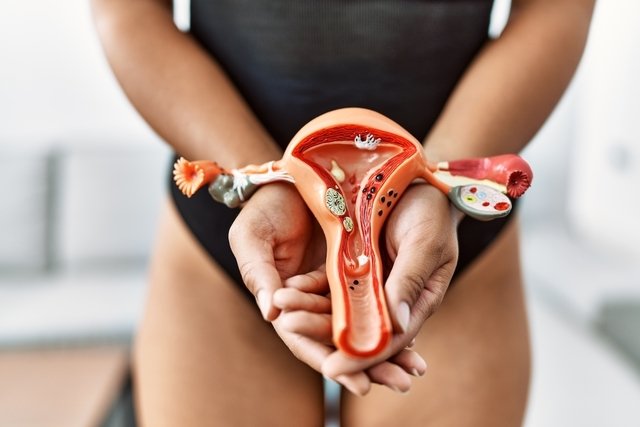Subserous myoma is a type of benign tumor made up of muscle cells that develops on the outer surface of the uterus, called the serosa. This type of fibroid generally causes few or no symptoms, however when it is very large it can cause abdominal pain and bleeding.
The risk of developing uterine fibroids is greater as a person ages, being more common in cases of family history of uterine fibroids and in women who have never been pregnant, for example.
If you suspect subserous myoma, it is important to consult a gynecologist for an evaluation. Although treatment is not always necessary, it can involve anything from anti-inflammatory medications to surgery.

Symptoms of subserous myoma
The main symptoms of subserous myoma are:
- Abdominal pain;
- Genital bleeding;
- Sensation of pressure in the abdomen;
- Frequent urge to urinate;
- Constipation;
- Pain during sexual intercourse.
The symptoms caused by subserous fibroids are not so different from those caused by other types of fibroids, however, subserous fibroids do not usually impair the ability to get pregnant. See how to identify the main symptoms of uterine fibroids.
Furthermore, symptoms tend to be more intense during pregnancy, which is a period in which the fibroid can grow and increase the risk of complications such as unfavorable positioning of the baby inside the uterus and premature birth. Know the symptoms and risks of myoma during pregnancy.
Possible causes
Subserous myoma is caused by the abnormal multiplication of muscle cells in the wall of the uterus and appears in the outer part of this organ, and can grow due to the stimulation of hormones such as estrogen and progesterone.
The risk of developing uterine fibroids is generally greater as a person ages, being more common in women who started menstruating early, have never been pregnant, entered menopause late and have a family history of fibroids in the uterus, for example.
How to confirm the diagnosis
The diagnosis is usually made by a gynecologist through evaluation of the symptoms presented and imaging tests, such as transvaginal ultrasound and magnetic resonance imaging.
How the treatment is carried out
Subserous fibroid treatment may not be necessary in cases where the fibroid causes few or no symptoms.
However, when subserosal fibroid treatment is indicated, it may involve:
1. Drug treatment
Medications such as non-steroidal anti-inflammatory drugs and oral hormonal contraceptives may be indicated in case of symptoms such as severe pain or frequent bleeding. In addition, there are medications that reduce the size of fibroids, however they are generally indicated before their removal through surgery. See the main medications indicated for the treatment of uterine fibroids.
2. Treatment through surgery
Surgeries such as myomectomy, which is the removal of just the fibroid, or even the removal of the entire uterus, may be indicated depending on the severity of symptoms, response to previous treatments and the woman’s desire to become pregnant, for example. See how surgery to remove the fibroid is performed and when it is indicated.
Bibliography
- STATPEARLS. Uterine Leiomyomata. 2021. Available at: <https://www.ncbi.nlm.nih.gov/books/NBK546680/>. Accessed on September 16, 2022
- GIULIANI, Emma; SANIE-AS, Sawsan; MARSH, Erica. Epidemiology and management of uterine fibroids. Int J Gynaecol Obstet. Vol.149, n.1. 3-9, 2020
- FREYTAG, Damaris et al. Uterine Fibroids and Infertility. Diagnostics (Basel). Vol.11, n.8. 1455, 2021
- INFORMED HEALTH. Uterine fibroids: Overview. 2014. Available at: <https://www.ncbi.nlm.nih.gov/books/NBK279535/>. Accessed on Aug 14, 2020
- NEWTON WELLESLEY HOSPITAL. Fibroids. Disponível em: <https://www.nwh.org/womens-health-center/center-for-minimally-invasive-gynecologic-surgery/fibroids>. Acesso em 14 ago 2020
- PORTUGUESE SOCIETY OF GYNECOLOGY. National Consensus on Uterine Fibroids. 2017. Available at: <http://www.spginecologia.pt/uploads/Consenso-sobre-miomas-2017-165×220-V12.pdf>. Accessed on Aug 10, 2020
- MINISTRY OF HEALTH. Clinical Protocol and Therapeutic Guidelines Uterine Leiomyoma. 2017. Available at: <http://conitec.gov.br/images/Relatorios/2017/Relatorio_PCDT_leiomioma_de_utero__CP_35_2017_1.pdf>. Accessed on Aug 10, 2020

Sign up for our newsletter and stay up to date with exclusive news
that can transform your routine!
Warning: Undefined array key "title" in /home/storelat/public_html/wp-content/plugins/link-whisper-premium/templates/frontend/related-posts.php on line 12
Warning: Undefined array key "title_tag" in /home/storelat/public_html/wp-content/plugins/link-whisper-premium/templates/frontend/related-posts.php on line 13



